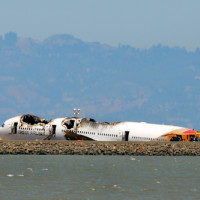Asiana Flight 214 One Year Later NTSB blames fatal crash in California on pilot error and automated Boeing systems

It was one year ago this month that Asiana Flight 214 from Seoul crashed into the runway at San Francisco International Airport, killing three and injuring dozens more. The National Transportation Safety Board (NTSB) is set to release its probable cause determination of the crash, which includes 30 separate findings. The report also makes 15 specific safety recommendations to the FAA, four to Asiana Airlines and two to Boeing regarding its automatic flight control systems and operating manual for the 777.
Background of Plane Crash
As had been known from the NTSB’s preliminary report, on July 6, 2013 the Boeing 777 Asiana Flight 214 from Seoul, South Korea was making its landing at San Francisco International Airport (SFO) when it impacted the seawall and then the runway before bursting into flames. Of the 291 passengers, four flight crewmembers and 12 flight attendants, 182 people were taken to the hospital with injuries, 49 of which were classified as serious injuries. The accident also took the lives of three passengers. As you may recall, one of the fatalities involved a passenger who had been ejected from the plane and was run over by two firefighting vehicles on their way to the crash. The NTSB notes that the two passengers who were ejected from the plane were not wearing their seatbelts and likely would not have been ejected from the cabin had they been belted at the time of the crash.
Probable Cause
Although final revisions are still being made before the report is released, the NTSB did provide a summary of the report at a public meeting held on June 24. Apparently, the trouble began when the flight crew mismanaged the descent to SFO. The pilot selected AUTOPILOT MODE to correct the descent, but this move instead initiated a climb because the plane was below the selected altitude. The pilot then disconnected AUTOPILOT and moved the thrusters to idle, but this caused the AUTOTHROTTLE to go into HOLD mode, a change which was not noticed by the flight crew. The pilots assumed AUTOTHROTTLE was maintaining the correct speed, but in actuality the speed was constantly decreasing.
It appears that there were several indications that the approach was not stabilized which the flight crew should have been aware of, prompting a go-around. Instead, however, the approach continued to destabilize. The flight crew finally initiated a go-around, but by then the plane was too low and traveling too slow, causing the main landing gear and aft fuselage to strike the seawall during the maneuver, at which point the tail of the plane broke off and the body of the craft crashed into the runway and caught fire.
Probable cause for the accident, then, was a combination of mismanagement of the descent,
unintended deactivation of automatic airspeed control, inadequate monitoring of airspeed, and a
delayed go-around. In addition to multiple pilot error, however, the NTSB also criticized Boeing for its automatic flight control systems and the quality of its flight crew operating manual for the 777. Hopefully, Boeing will initiate changes, and Asiana and other airlines will revise their training, to prevent such accidents in the future.


 Close Menu
Close Menu